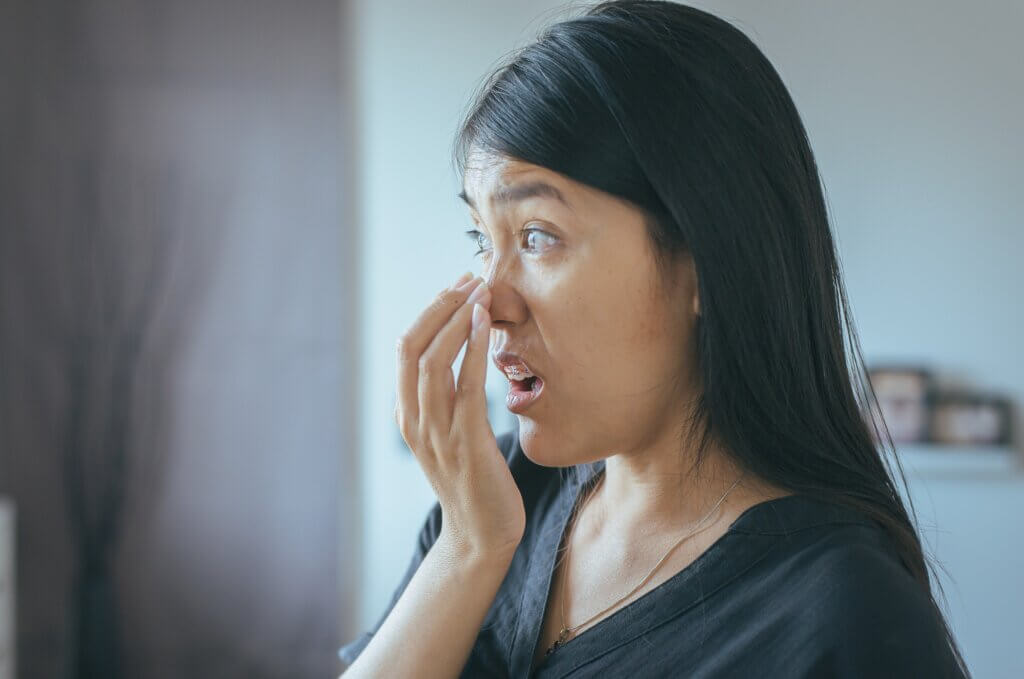This is How Tobacco Affects Teeth

According to the World Health Organization (WHO), about 8 million people around the world die from tobacco-related causes each year. 7 million of these deaths are exclusively related to its consumption. Smoking has an impact on almost every part of the body, and it quite clearly also has an impact on oral health. Today we’ll have a look at how tobacco affects teeth.
Smoking is considered a public health problem. It not only affects the smokers themselves, but also those around them. Indeed, passive smokers are also exposed to the problems associated with tobacco, so much so that the highest health body estimates that 1.2 million people die each year from secondhand smoke. Let’s see how tobacco affects teeth.
7 ways that tobacco affects teeth
The campaigns over the last few decades have significantly raised awareness in relation to how damaging tobacco is for our general health. Even so, millions of people around the world smoke every day – especially in low- and middle-income countries. We’re going to show you 7 effects that tobacco has on the teeth according to scientists.
1. Discoloration of the teeth
A study published in BMC Public Health in 2005 found a positive association between smoking and tooth discoloration. Mild tooth discoloration is relatively common in nonsmokers, but those who are exposed to tobacco on a recurring basis develop moderate to severe discoloration.
The impact is so noticeable that the researchers found that up to 30% of the smokers surveyed expressed dissatisfaction with the color of their teeth. This has a direct impact on aesthetics, and also on self-esteem. As a consequence, many are self-conscious about showing their teeth in social situations, such as smiling in front of others.
2. Halitosis (bad breath)

An article published in 2022 in Toxicology Reports found that smokers show experience more cases of halitosis when compared to non-smokers. In fact, tobacco is the second direct cause of bad breath (the first is periodontal disease). Many smokers are unaware of this, partly because they adapt to the smell relatively quickly.
Bad breath has a direct impact on the way you relate to other people. Those who suffer from bad breath tend to minimize their interaction with others, and those close to them tend to do the same. As a consequence, they may opt for isolation and withdrawn attitudes. This also has a direct impact on self-esteem.
3. Periodontal disease
A clear link has been found between smoking and periodontal disease. Tobacco can initiate, extend and worsen this condition. Periodontitis, as it’s also known, is a chronic disease that over time usually destroys the bone that supports the teeth. In its initial stages it doesn’t cause symptoms, so it can go unnoticed until it evolves into more serious conditions.
4. Tooth decay and loss
A meta-analysis published in Tobacco Induced Diseases in 2019 found a clear correlation between smoking and cavities. Caries is a chronic disease that causes the destruction of tooth tissue.
It appears as a consequence of the acids produced by the bacteria. They’re the main cause of tooth pain and tooth loss, so smoking increases the chances of developing it compared to the general population.
5. Accumulation of plaque and tartar on the teeth
There is also evidence that tobacco is a risk factor for the accumulation of plaque and tartar in teeth. Plaque is the accumulation of a bacterial film that adheres to the surface of the teeth. Its color is yellowish or brown, and can be removed with the help of proper oral hygiene. If the latter is not done, and if smoking continues, it can lead to tartar.
Indeed, tartar is the continuation of dental plaque and is related to different complications. Tartar can destroy enamel, which can lead to tooth sensitivity. It can also worsen episodes of bad breath, cavities, tooth loss, and periodontitis. It’s often a condition that is underestimated when detected at home.
6. Bone loss in the jaw
The sum of the above conditions results in bone loss in the jaw. Corrosion of the jaw bone causes various complications, such as difficulty speaking, headaches, facial pain, pain when chewing, eating problems, and even facial malformations. Its consequences are functional, aesthetic, and psychological.
7. Oral cancer

We cannot list how tobacco affects teeth without referring to oral cancer. The relationship between oral cancer and smoking is not currently discussed, and most cases correspond to oral squamous cell carcinoma (OSCC). Oral cancer is the eighth most deadly form of cancer around the world and claims very many lives.
According to recent estimates, up to 30.5% of deaths worldwide from oral cancer are directly related to smoking. Although it’s true that this number has gone down in many parts of the world, these percentages show that awareness campaigns haven’t had the impact that the authorities expected and hoped for.
Tobacco affects teeth in different ways, and always negatively. Its effects can still be felt for a while after you quit smoking, although the sooner you quit, the better overall health results you’ll get. Consult our guide to quit smoking and a specialist if you want to minimize these and other complications related to smoking.
According to the World Health Organization (WHO), about 8 million people around the world die from tobacco-related causes each year. 7 million of these deaths are exclusively related to its consumption. Smoking has an impact on almost every part of the body, and it quite clearly also has an impact on oral health. Today we’ll have a look at how tobacco affects teeth.
Smoking is considered a public health problem. It not only affects the smokers themselves, but also those around them. Indeed, passive smokers are also exposed to the problems associated with tobacco, so much so that the highest health body estimates that 1.2 million people die each year from secondhand smoke. Let’s see how tobacco affects teeth.
7 ways that tobacco affects teeth
The campaigns over the last few decades have significantly raised awareness in relation to how damaging tobacco is for our general health. Even so, millions of people around the world smoke every day – especially in low- and middle-income countries. We’re going to show you 7 effects that tobacco has on the teeth according to scientists.
1. Discoloration of the teeth
A study published in BMC Public Health in 2005 found a positive association between smoking and tooth discoloration. Mild tooth discoloration is relatively common in nonsmokers, but those who are exposed to tobacco on a recurring basis develop moderate to severe discoloration.
The impact is so noticeable that the researchers found that up to 30% of the smokers surveyed expressed dissatisfaction with the color of their teeth. This has a direct impact on aesthetics, and also on self-esteem. As a consequence, many are self-conscious about showing their teeth in social situations, such as smiling in front of others.
2. Halitosis (bad breath)

An article published in 2022 in Toxicology Reports found that smokers show experience more cases of halitosis when compared to non-smokers. In fact, tobacco is the second direct cause of bad breath (the first is periodontal disease). Many smokers are unaware of this, partly because they adapt to the smell relatively quickly.
Bad breath has a direct impact on the way you relate to other people. Those who suffer from bad breath tend to minimize their interaction with others, and those close to them tend to do the same. As a consequence, they may opt for isolation and withdrawn attitudes. This also has a direct impact on self-esteem.
3. Periodontal disease
A clear link has been found between smoking and periodontal disease. Tobacco can initiate, extend and worsen this condition. Periodontitis, as it’s also known, is a chronic disease that over time usually destroys the bone that supports the teeth. In its initial stages it doesn’t cause symptoms, so it can go unnoticed until it evolves into more serious conditions.
4. Tooth decay and loss
A meta-analysis published in Tobacco Induced Diseases in 2019 found a clear correlation between smoking and cavities. Caries is a chronic disease that causes the destruction of tooth tissue.
It appears as a consequence of the acids produced by the bacteria. They’re the main cause of tooth pain and tooth loss, so smoking increases the chances of developing it compared to the general population.
5. Accumulation of plaque and tartar on the teeth
There is also evidence that tobacco is a risk factor for the accumulation of plaque and tartar in teeth. Plaque is the accumulation of a bacterial film that adheres to the surface of the teeth. Its color is yellowish or brown, and can be removed with the help of proper oral hygiene. If the latter is not done, and if smoking continues, it can lead to tartar.
Indeed, tartar is the continuation of dental plaque and is related to different complications. Tartar can destroy enamel, which can lead to tooth sensitivity. It can also worsen episodes of bad breath, cavities, tooth loss, and periodontitis. It’s often a condition that is underestimated when detected at home.
6. Bone loss in the jaw
The sum of the above conditions results in bone loss in the jaw. Corrosion of the jaw bone causes various complications, such as difficulty speaking, headaches, facial pain, pain when chewing, eating problems, and even facial malformations. Its consequences are functional, aesthetic, and psychological.
7. Oral cancer

We cannot list how tobacco affects teeth without referring to oral cancer. The relationship between oral cancer and smoking is not currently discussed, and most cases correspond to oral squamous cell carcinoma (OSCC). Oral cancer is the eighth most deadly form of cancer around the world and claims very many lives.
According to recent estimates, up to 30.5% of deaths worldwide from oral cancer are directly related to smoking. Although it’s true that this number has gone down in many parts of the world, these percentages show that awareness campaigns haven’t had the impact that the authorities expected and hoped for.
Tobacco affects teeth in different ways, and always negatively. Its effects can still be felt for a while after you quit smoking, although the sooner you quit, the better overall health results you’ll get. Consult our guide to quit smoking and a specialist if you want to minimize these and other complications related to smoking.
- Alkhatib MN, Holt RD, Bedi R. Smoking and tooth discolouration: findings from a national cross-sectional study. BMC Public Health. 2005;5:27. Published 2005 Mar 24.
- Borojevic T. Smoking and periodontal disease. Mater Sociomed. 2012;24(4):274-276.
- Jiang X, Jiang X, Wang Y, Huang R. Correlation between tobacco smoking and dental caries: A systematic review and meta-analysis. Tob Induc Dis. 2019;17:34. Published 2019 Apr 19.
- Jiang X, Wu J, Wang J, Huang R. Tobacco and oral squamous cell carcinoma: A review of carcinogenic pathways. Tob Induc Dis. 2019;17:29. Published 2019 Apr 12.
- Kauss AR, Antunes M, Zanetti F, et al. Influence of tobacco smoking on the development of halitosis. Toxicol Rep. 2022;9:316-322. Published 2022 Mar 6.
- Kumar PS, Matthews CR, Joshi V, de Jager M, Aspiras M. Tobacco smoking affects bacterial acquisition and colonization in oral biofilms. Infect Immun. 2011;79(11):4730-4738.
- Nocini R, Lippi G, Mattiuzzi C. The worldwide burden of smoking-related oral cancer deaths. Clin Exp Dent Res. 2020;6(2):161-164.
Este texto se ofrece únicamente con propósitos informativos y no reemplaza la consulta con un profesional. Ante dudas, consulta a tu especialista.







